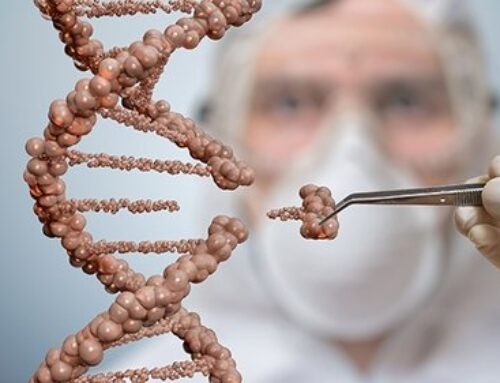Original article from The New England Journal of Medicine
George Q. Daley, M.D., Ph.D., Robin Lovell-Badge, Ph.D., and Julie Steffann, M.D., Ph.D.
 The recent announcement of the birth of twins whose genomes were edited during in vitro fertilization (IVF) has engendered broad condemnation for the premature clinical deployment of a fledgling but powerful biotechnology. The Chinese scientist He Jiankui may claim priority for the first use of CRISPR-Cas9 genome editing in human embryos, but he will forever be remembered for his reckless flouting of widely articulated scientific, clinical, and ethical standards. CRISPR-Cas9, which first appeared in the scientific literature only 7 years ago, (1) is a programmable, sequence-directed, RNA-guided nuclease whose rapid assimilation has transformed biomedical
The recent announcement of the birth of twins whose genomes were edited during in vitro fertilization (IVF) has engendered broad condemnation for the premature clinical deployment of a fledgling but powerful biotechnology. The Chinese scientist He Jiankui may claim priority for the first use of CRISPR-Cas9 genome editing in human embryos, but he will forever be remembered for his reckless flouting of widely articulated scientific, clinical, and ethical standards. CRISPR-Cas9, which first appeared in the scientific literature only 7 years ago, (1) is a programmable, sequence-directed, RNA-guided nuclease whose rapid assimilation has transformed biomedical
research and promises clinical applications in gene-repair strategies to treat disorders such as sickle cell anemia, congenital forms of blindness, and muscular dystrophy. The existing regulatory framework for somatic gene therapy using viral vectors has been honed through decades of trials and should be effective at balancing scientific rigor, patient safety, and innovation for trials of somatic genome editing. Treating disease by genome editing of somatic tissues raises few ethical concerns, as long as patient welfare is prioritized. The promise far outweighs the medical risk. Genome editing of early human embryos raises far greater concern because it can lead to heritable changes in the germline. But though the world’s first application of embryo editing was deeply flawed, not least because it didn’t address an unmet clinical need, and has prompted calls for a moratorium or an outright ban, we believe that halting research and deliberation on more responsible ways to maximize human benefit would be unwise.
Embryo editing poses scientific and ethical hurdles. In 2015, after the first report that genome editing had been applied to human embryos in vitro, (2) the U.S. National Academies of Sciences, Engineering, and Medicine, the Royal Society of the United Kingdom, and the Chinese Academy of Sciences convened the First International Summit on Human Gene Editing to discuss the scientific, social, ethical, and regulatory questions raised by somatic-tissue editing and germline editing involving either gametes or embryos. The organizing committee recognized the imminent clinical application of somatic-tissue editing to treat disease, and it endorsed
further research on genome editing in human embryos to explore early human development and define the fidelity of genome editing for averting genetic disease in children. The committee stated strongly that any clinical use of the latter would be premature and irresponsible and called for further deliberation by international groups to promote a uniform scientific and ethical framework and to determine which, if any, clinical indications might be deemed permissible.
The Second International Summit on Human Genome Editing, held in Hong Kong in November 2018 under the auspices of the U.S. National Academies of Science and Medicine, the U.K. Royal Society, and the Hong Kong Academy of Sciences, was dominated by the startling announcement of the birth of the genome-edited twins. Nonetheless, the organizing committee reiterated that “the scientific understanding and technical requirements for clinical practice remain too uncertain and the risks too great to permit clinical trials of germline editing at this time” and that He’s report was “deeply disturbing . . . irresponsible and failed to conform with international norms.” The 2018 summit also highlighted the scientific advances of the past 3 years, which have yielded remarkably precise editing techniques with vanishingly low rates of off-target mutagenesis, as well as new base-editing methods that avoid potentially deleterious DNA double-strand breaks. Equivalent progress has been made in the ethical arena. Virtually all of the 60-plus groups that have reported on the scientific and ethical landscape of genome editing3 have deemed clinical embryo editing premature, but some acknowledge its potential permissibility for avoiding the transmission of genetic disease by at-risk couples. This potential is predicated on achievement of greater scientific understanding and broader societal acceptance of specific clinical uses. On the scientific front, any translational pathway will require standards to define on-target efficacy and potentially off-target, deleterious mutations. Functional assessments in cells and model organisms are essential to further elucidate the risks of toxicity. For genome editing in human embryos, consensus will be needed about techniques that minimize mosaicism — the incomplete or nonuniform editing in the individual cells of early embryos. Unanswered questions include how best to standardize clinical approaches, how to ensure practitioner expertise before clinical practice, and how to monitor children born after the use of these methods while respecting their privacy. There are also difficult questions about cost, accessibility, and social justice that will need answers once the methods are shown to be effective and safe. And there’s the question of whether we need a licensing or regulatory authority with the expertise to evaluate the nature of specific genetic alterations, the clinical need for them, relevant pre-clinical data, and clinical protocols. On the ethics front, virtually all deliberative bodies have called for broad public engagement in consideration of various applications, and they recommend that genome editing in human embryos proceed only if the scientific and societal issues can be adequately addressed, as determined in countries or regions exerting regulatory jurisdiction.
Of greatest concern is editing of genes to confer advantageous traits not related to avoiding disease or preserving health. Efforts to optimize traits such as intelligence, memory, creativity, bravery, or strength raise the specter of eugenics — and thorny questions about social justice. If ever allowed, would such interventions be accessible to only a privileged few and thus exacerbate inequality? What about potentially advantageous editing of genes that confer risk of cardiovascular disease, stroke, dementia, cancer, or susceptibility to infectious disease (as in He’s experiment, whose goal was resistance to HIV)? Here the risk–benefit balance is harder to calculate, and most groups have concluded that such trade-offs cannot be rationalized right now, at least not without more extensive knowledge of the genes and gene variants involved. Which leaves prevention of devastating genetic conditions as the most compelling potential application of germline genome editing. There are thousands of such conditions known to result from rare gene variants with mendelian inheritance in which the disease allele is well understood and its reversion to the common form in the healthy population is unlikely to do harm. When both members of a couple carry homozygous recessive disease alleles or one is homozygous for an autosomal dominant disease allele such as that for Huntington’s disease, genome editing offers the only prospect of bearing a healthy, genetically related child. Though such cases are exceedingly rare overall, they occur in clusters when the disease allele’s frequency is high within a social or geographical group. Moreover, rarity has never kept families from pursuing medical solutions; indeed, the ultra-orphan diseases that have driven the aggressive pursuit of viral gene therapy are far rarer than
the many single-gene disorders that might be addressed by genome editing in human embryos. Regarding the more common challenge — couples at risk of transmitting an autosomal recessive or dominant genetic disease— it has been argued that genome editing is unnecessary because IVF with pre-implantation genetic diagnosis (PGD) can identify disease-free embryos. Unfortunately, in the majority of such cases, PGD fails to result in the birth of a healthy child. Many embryos are unsuitable for transfer because they are affected by the genetic disease or are of poor quality. Moreover, in some women and in some genetic conditions that compromise fertility, few embryos can be obtained. Data from the European Society of Human Reproduction and Embryology Consortium suggest that in 2011– 2012, the success rate of PGD for preventing monogenic diseases was 20%.4 The PGD Centre of Béclère-Necker Hospitals reported successful live births after only 18% of cycles in which oocytes were retrieved, and an overall rate of births of healthy babies of only 27% among couples who underwent multiple cycles.5 A substantial percentage (27%) of PGD cycles produce no viable, diseasefree embryos for transfer. Autosomal dominant diseases (e.g., myotonic dystrophy, Huntington’s disease, and neurofibromatosis type 1) are common indications for PGD. Here, the failure rate is higher because only 50% of embryos are expected to be disease-free. Applying genome editing could rescue otherwise viable embryos that were carrying the abnormal allele and theoretically double the probability of the birth of a healthy baby. Moreover, genome editing at the very early stages of human development may be more effective than somatic therapies at eliminating a genetic defect: it would not only treat the individual but would also eradicate the disease from subsequent generations. With some conditions, such as diseases affecting motor neurons or the brain, by the time of birth, it is already too late to use somatic therapies. The risk of genetic disease in offspring of unrelated individuals is estimated at 1 to 4%. With the rise of consumer genomics and the falling cost of whole-genome sequencing, at-risk couples are bound to seek any future genetic interventions that permit them to have healthy children. Moreover, with the increasing success of conventional treatments and somatic gene therapy, many more people with genetic diseases will survive to reproductive age and want to have their own children without passing on the disease gene. Germline genome editing may ultimately prove a more efficient and effective means of eliminating disease. The prospect of genome editing
to prevent genetic disease, if determined to be safe, enjoys widespread public support, as shown by published opinion polls and engagement activities. There is, however, robust opposition to editing genomes to enhance human traits, which suggests that applications of any methods deemed permissible will have to be regulated to protect against misuse. In the long run, our greatest protection against inappropriate genome editing may be the implausibility of influencing traits such as intelligence, which emerge from complex interactions among multiple genes and environments. Our ignorance regarding such complexity may ultimately save us from the hazards of humanity’s hubris.
Disclosure forms provided by the authors are available at NEJM.org.
From Harvard Medical School, Boston (G.Q.D.); the Francis Crick Institute, Lon‑ don (R.L.-B.); and Université Paris Des‑ cartes, Imagine Inserm UMR1163, Service de Génétique Moléculaire, Hôpital NeckerEnfants Malades, Paris (J.S.).
This article was published on January 16, 2019, at NEJM.org.
1. Jinek M, Chylinski K, Fonfara I, Hauer
M, Doudna JA, Charpentier E. A programmable dual-RNA-guided DNA endonuclease in adaptive bacterial immunity. Science 2012;337:816-21.
2. Liang P, Xu Y, Zhang X, et al. CRISPR/Cas9-mediated gene editing in human tripronuclear zygotes. Protein Cell 2015;6:363-72.
3. Brokowski C, Adli M. CRISPR ethics: moral considerations for applications of a powerful tool. J Mol Biol 2019;431:88-101.
4. De Rycke M, Goossens V, Kokkali G, Meijer-Hoogeveen M, Coonen E, Moutou C.
ESHRE PGD Consortium data collection XIV-XV: cycles from January 2011 to December 2012 with pregnancy follow-up to October 2013. Hum Reprod 2017;32:1974-94.
5. Steffann J, Jouannet P, Bonnefont JP, Chneiweiss H, Frydman N. Could failure in preimplantation genetic diagnosis justify editing the human embryo genome? Cell Stem Cell 2018;22:481-2. DOI: 10.1056/NEJMp1900504
Copyright © 2019 Massachusetts Medical Society



